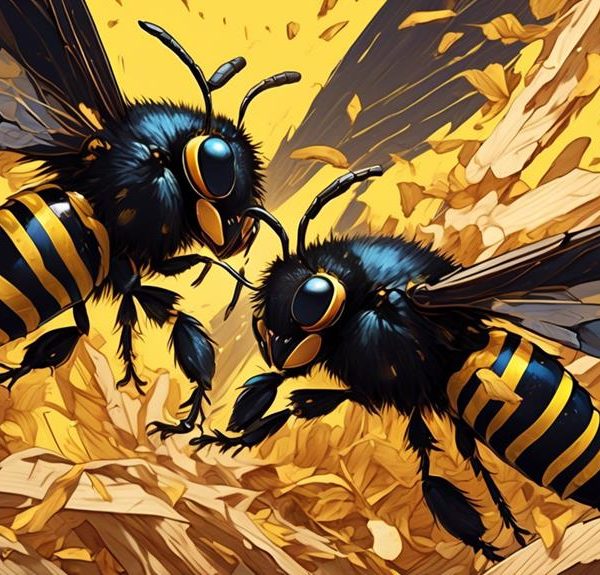Peek into the intriguing world of carpenter bees, as we delve into the factors influencing how long they take to drill holes in wood.
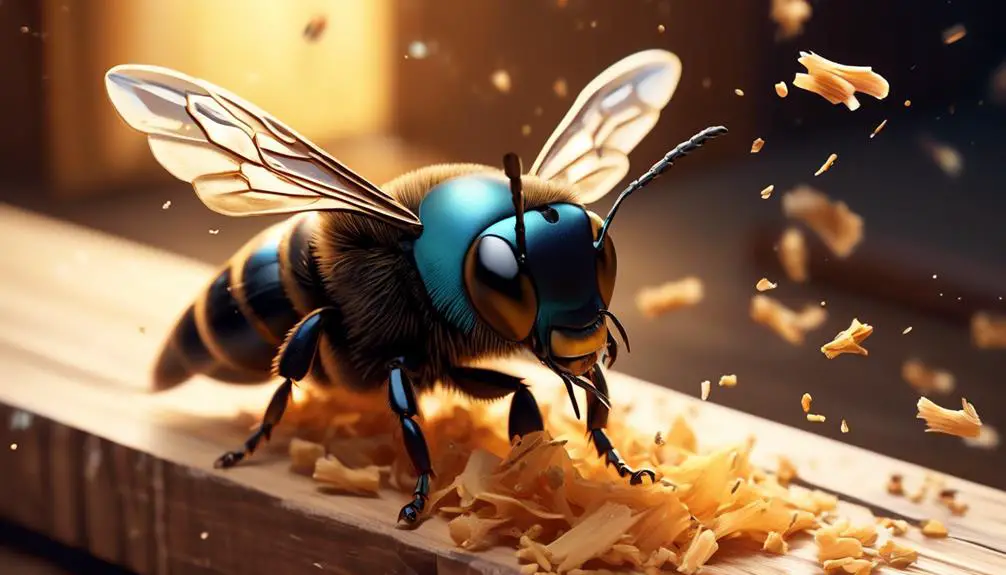
How Long Does It Take a Carpenter Bee to Make a Hole
Imagine you're watching a carpenter bee buzzing around your wooden fence. You notice it start to drill into the wood, creating a small hole. You're curious – how long does it take for this tiny creature to carve out such a space?
The answer isn't as straightforward as you'd think. Many factors come into play, from the bee's species and the wood's hardness to environmental conditions. Intriguingly, the pace at which these bees work can offer insight into their behavior and life cycle.
Stick around if you're keen to explore the fascinating world of carpenter bees and their industrious nature.
Key Takeaways
- Carpenter bees have a precise methodology for creating holes in wood, starting with a 1/2 inch deep hole as the entrance to their nest and extending the tunnel to a depth of 1 to 2 feet over several days.
- Factors such as the type of wood, weather conditions, and the health and competition of the bees can influence the construction speed.
- Different species of carpenter bees have varying drilling speeds based on their adaptability, strength, size, and wood preference.
- To protect wood from carpenter bees, reinforcing with physical barriers, treating with insecticides, and applying wood stains or paint can be effective preventative measures. Regular inspections and monitoring are also important.
Understanding Carpenter Bee Behavior
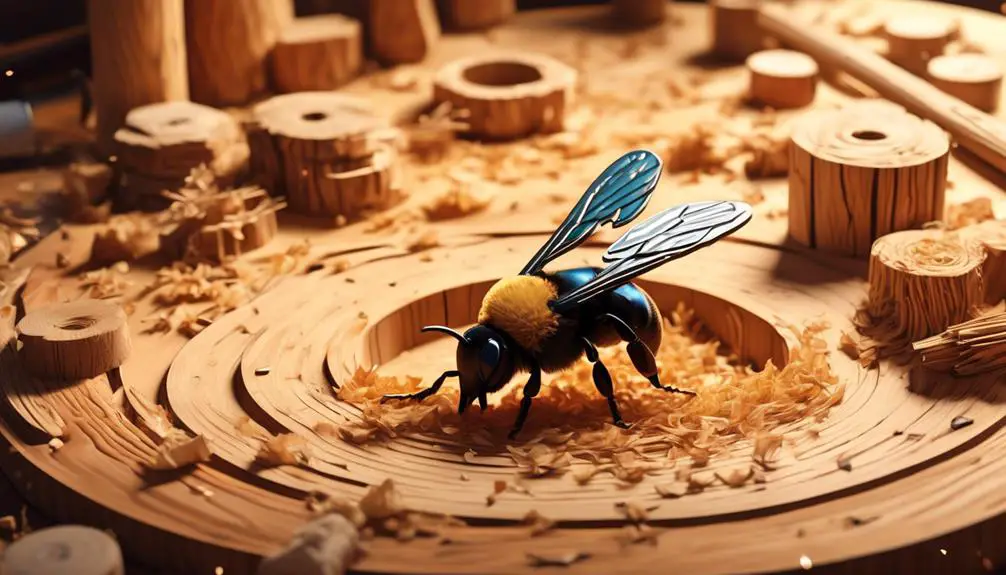
To truly grasp the behavior of carpenter bees, you'll first need to delve into their fascinating process of hole creation, a meticulous task that showcases their industrious nature. They're not just randomly drilling; there's a precise methodology behind each hole they create.
Their first step, you'll find, is the selection of a suitable wood surface. Preferring untreated and weathered wood, they'll often choose your deck or fence for their projects. Once they've found their material, they'll start their work, using their mandibles to excavate and pull out wood particles.
Their efficiency is remarkable. Within a day, they're able to create a hole about 1/2 inch deep, which serves as the entrance to their nest. But they don't stop there. Over several days, they'll extend this tunnel to a depth of about 1 to 2 feet, making it a perfect place for laying their eggs.
Their hole creation process is a testament to their perseverance and hard work. Understanding this, you'll appreciate not only their industrious nature but also their significant role in the ecosystem. After all, they're not just pests; they're also pollinators and wood recyclers in the world of nature.
The Construction Process of Bee Holes
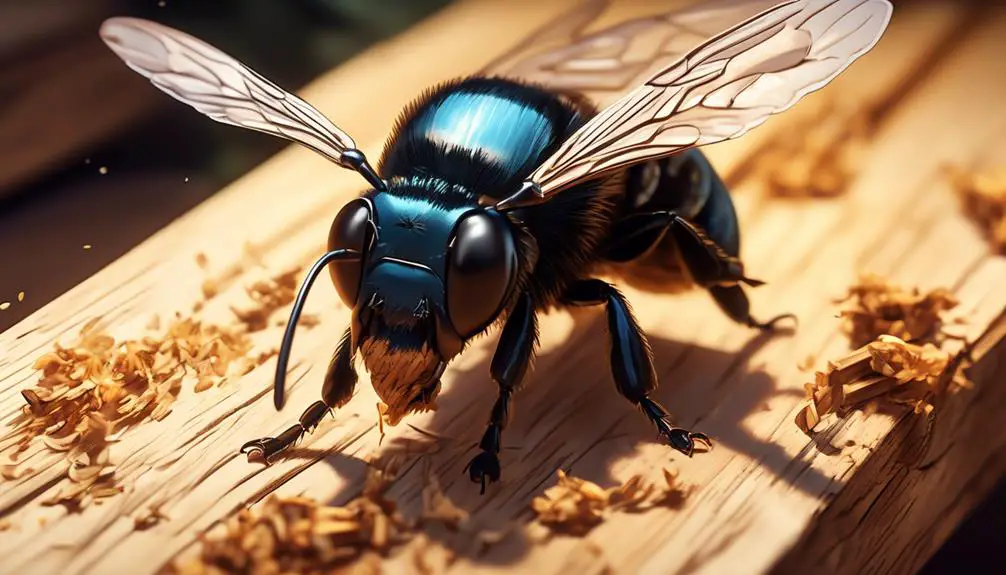
Building on this understanding of carpenter bees' industrious nature, let's take a closer look at their meticulous construction process for these holes.
Typically, a carpenter bee starts by locating a suitable piece of wood, preferably untreated and weathered. Once a site is chosen, the bee uses its strong mandibles to bore a perfectly round entrance hole, about the diameter of your finger.
This entryway, interestingly, is just the beginning. After the initial hole is drilled, the bee makes a sharp 90-degree turn. It then continues to excavate sideways, parallel to the wood's surface. This horizontal tunnel, or gallery, can extend up to 10 feet in length, depending on the wood's condition and the bee's needs.
During construction, the bee doesn't eat the wood. Instead, it discards the wood shavings outside the hole. This process leaves behind a telltale pile of sawdust, a clear sign of carpenter bee activity.
The bee's construction project isn't a quick job. It can take from a few days to a week to complete, depending on various factors. These include the bee's health, the wood's hardness, and environmental conditions.
Remarkably, all this meticulous work is done by a single bee, demonstrating its exceptional industriousness and precision.
Factors Influencing Construction Speed

The speed at which a carpenter bee constructs its hole is influenced by several factors, each playing a unique role in this intricate process.
Firstly, the type of wood matters. Hardwoods such as oak or maple slow down the bee's progress significantly, while softer woods like pine or cedar can be tunneled through more quickly.
Secondly, the weather plays a part. In colder conditions, a bee's metabolic rate slows down, reducing its energy levels and thus its digging speed. Conversely, warm, sunny weather can speed up the process considerably.
Thirdly, the bee's age and health status are critical. Younger, healthier bees tend to work faster and more efficiently than older or sick ones.
Then there's competition. In areas with high bee populations, bees might work faster to secure a nesting site before others do.
Lastly, the size of the hole influences the construction speed. Larger holes, obviously, take longer to create than smaller ones.
Understanding these factors can help you better predict how long it will take a carpenter bee to make a hole in your wood structures. It's an intricate interplay of nature, demonstrating that even seemingly simple tasks entail a complex array of considerations.
Comparing Different Carpenter Bee Species
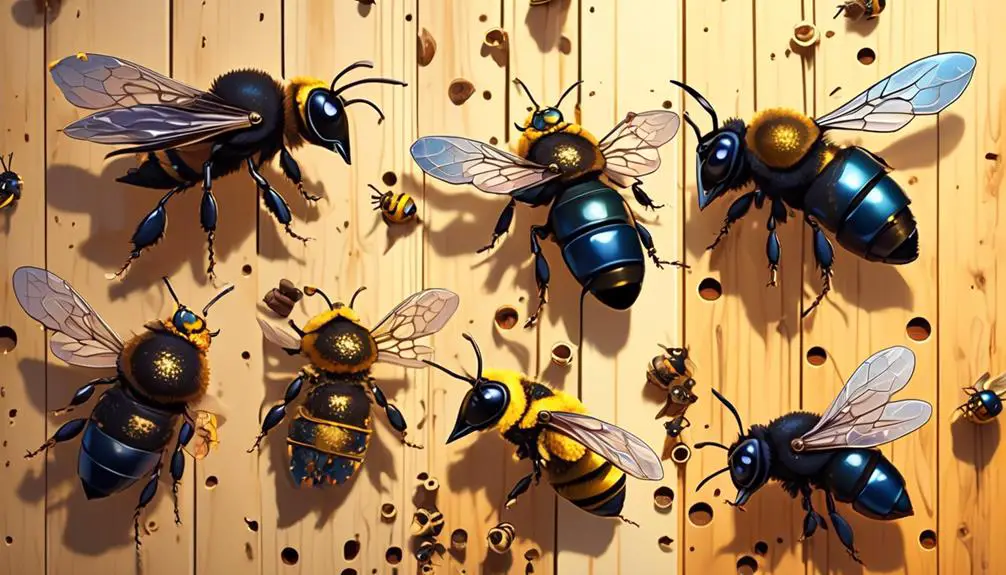
Diving into the world of different carpenter bee species, you'll find that each one, with its unique characteristics and behaviors, displays varying efficiencies when it comes to hole creation.
You've got the Xylocopa virginica, found primarily in North America, which is known for its rapid hole construction. Their burrows are created within 5 to 7 days on average, with the speed being attributed to their larger size and strength.
Then, there's the Xylocopa varipuncta, or the Valley Carpenter Bee, which takes a slightly longer span of 10 days. Their slower speed is attributed to their preference for harder wood types.
Similarly, the Xylocopa pubescens, a species found in Europe, is known to take up to two weeks due to its smaller size and the hardness of the wood it prefers.
Each species' drilling speed is reflective of its adaptability, strength, size, and preference for wood hardness. Keep in mind that these are averages; individual bees may vary based on external factors such as weather conditions and availability of resources.
Your understanding of these differences can help in predicting and managing carpenter bee activities.
Protecting Wood From Carpenter Bees
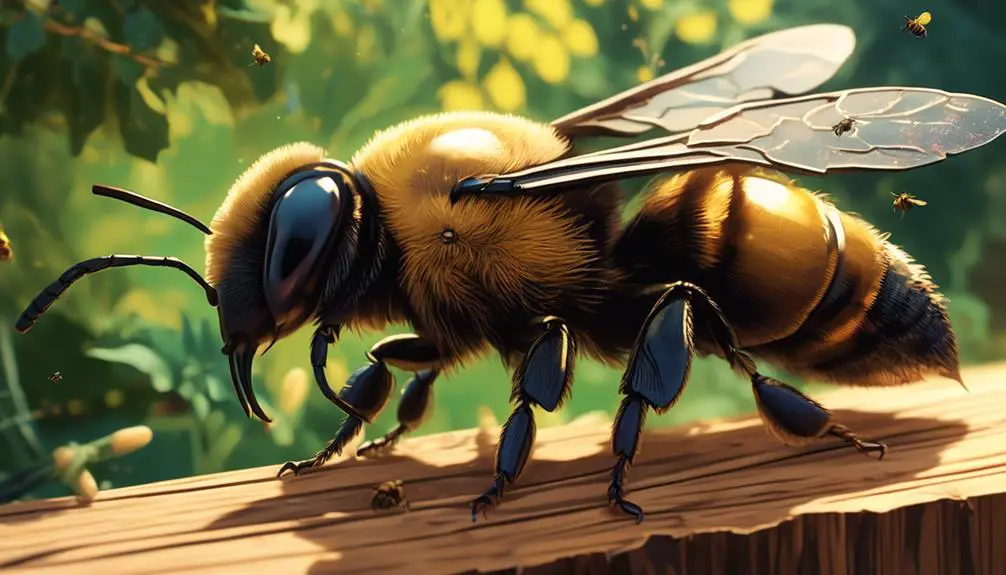
Understanding the different species of carpenter bees and their nesting habits is key, but it's equally crucial to know how to protect your wooden structures from their activities. Reinforcing exposed wood with a physical barrier, such as aluminum flashing, is one effective method. You'll prevent the bees from boring into the wood and establishing nests.
Another approach involves treating the wood with insecticides. Opt for products containing cyfluthrin or deltamethrin. These chemicals have been proven to effectively deter carpenter bees. However, exercise caution while using such substances to avoid unnecessary environmental impact and potential health hazards.
Last but not least, consider using wood stains or paint. Carpenter bees prefer untreated wood, so applying a layer of paint or stain can make your wooden structures less appealing to them. Choose oil-based over water-based products for better protection.
Regular inspection is also vital. Early detection of carpenter bee activity can help mitigate potential damage. If you notice small, round holes in the wood or see bees hovering around, it's time to take action.
Ultimately, protecting your wooden structures from carpenter bees requires a combination of preventative measures and vigilant monitoring.
Conclusion
You've journeyed through the intriguing world of carpenter bees. Now you understand, it takes around 5-7 days for them to complete a hole, influenced by species, weather, and wood hardness.
You've compared different species and now know how to protect your wood.
Keep observing these industrious creatures, they're fascinating, aren't they? Remember, knowledge is the first step in coexisting with these buzzy buddies.

